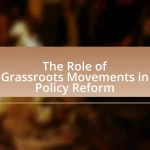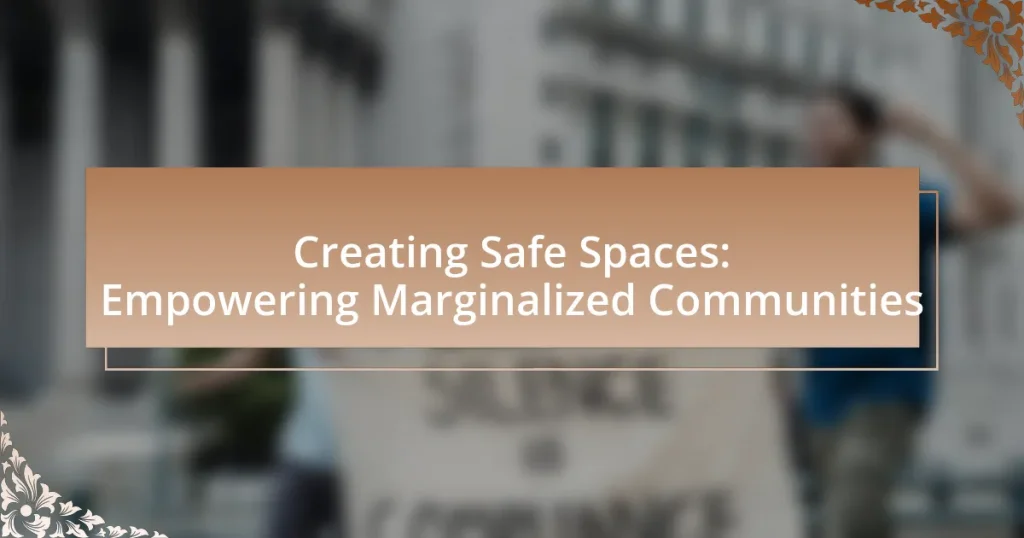Safe spaces are defined as environments where individuals from marginalized communities can engage without fear of discrimination or judgment, fostering belonging and mental well-being. This article explores the importance of safe spaces in empowering marginalized groups, addressing their specific needs, and promoting inclusivity. It discusses the characteristics of effective safe spaces, the role of community involvement, and the necessary training for facilitators. Additionally, it examines the challenges faced by safe spaces, including societal attitudes and funding issues, while highlighting strategies for their creation, maintenance, and evaluation to ensure relevance and effectiveness in supporting marginalized communities.
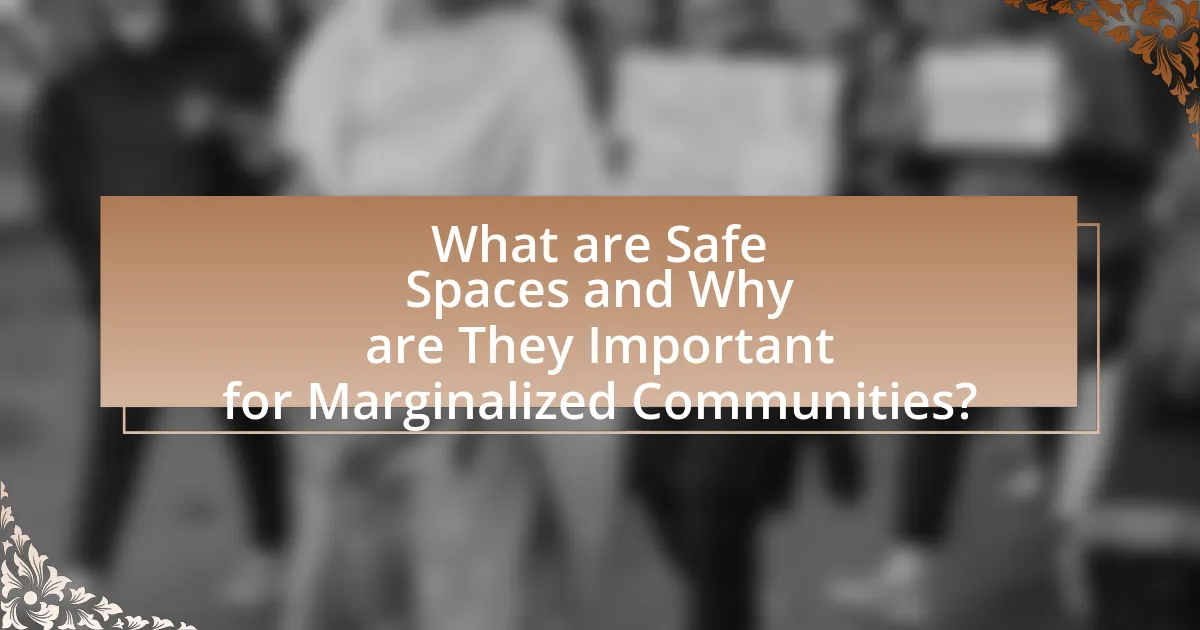
What are Safe Spaces and Why are They Important for Marginalized Communities?
Safe spaces are environments where individuals, particularly from marginalized communities, can engage without fear of discrimination, harassment, or judgment. These spaces are crucial for fostering a sense of belonging, promoting mental well-being, and encouraging open dialogue among individuals who share similar experiences or identities. Research indicates that safe spaces can significantly enhance the psychological safety of participants, allowing them to express themselves freely and build supportive networks. For instance, a study published in the Journal of Community Psychology highlights that safe spaces contribute to increased self-esteem and resilience among LGBTQ+ youth, demonstrating their vital role in empowering marginalized groups.
How do Safe Spaces contribute to the empowerment of marginalized communities?
Safe spaces contribute to the empowerment of marginalized communities by providing environments where individuals can express themselves freely without fear of discrimination or judgment. These spaces foster a sense of belonging and support, enabling community members to share their experiences, build confidence, and develop leadership skills. Research indicates that safe spaces can enhance mental well-being and resilience, as they allow marginalized individuals to connect with others who share similar challenges, thereby reinforcing their identities and promoting collective action. For instance, a study published in the Journal of Community Psychology highlights that participation in safe spaces leads to increased self-efficacy and community engagement among LGBTQ+ youth, demonstrating the tangible benefits of such environments in empowering marginalized groups.
What specific needs do marginalized communities have that Safe Spaces address?
Safe Spaces address the specific needs of marginalized communities by providing a secure environment for expression, support, and empowerment. These spaces facilitate open dialogue, allowing individuals to share their experiences without fear of judgment or discrimination. Research indicates that marginalized groups, such as LGBTQ+ individuals and racial minorities, often face systemic barriers and social isolation; Safe Spaces counteract these challenges by fostering community connections and promoting mental well-being. For instance, a study by the Human Rights Campaign found that 70% of LGBTQ+ youth reported feeling safer in supportive environments, highlighting the critical role Safe Spaces play in addressing their unique emotional and social needs.
How do Safe Spaces foster a sense of belonging and security?
Safe spaces foster a sense of belonging and security by providing environments where individuals can express themselves without fear of judgment or discrimination. These spaces encourage open dialogue and mutual respect, allowing marginalized communities to share their experiences and connect with others who understand their challenges. Research indicates that safe spaces can significantly enhance psychological well-being; for instance, a study published in the Journal of Community Psychology found that participants in supportive environments reported higher levels of self-esteem and lower levels of anxiety. This supportive atmosphere not only affirms individual identities but also cultivates a collective identity, reinforcing social bonds and community cohesion.
What are the key characteristics of effective Safe Spaces?
Effective Safe Spaces are characterized by inclusivity, confidentiality, and support. Inclusivity ensures that all individuals, regardless of their background, feel welcome and valued, fostering a sense of belonging. Confidentiality protects participants’ privacy, allowing them to share their experiences without fear of judgment or repercussions. Support is provided through active listening and validation, creating an environment where individuals can express themselves freely and seek help. Research indicates that these characteristics enhance trust and engagement, making Safe Spaces more effective in empowering marginalized communities.
What physical and emotional elements define a Safe Space?
A Safe Space is defined by both physical and emotional elements that foster a sense of security and acceptance. Physically, a Safe Space is characterized by accessibility, comfort, and a welcoming environment, often featuring inclusive signage, appropriate seating arrangements, and resources that reflect the diversity of the community it serves. Emotionally, it is defined by trust, respect, and open communication, where individuals feel free to express their identities and experiences without fear of judgment or discrimination. Research indicates that environments promoting psychological safety enhance well-being and participation, as shown in studies by Amy Edmondson, which highlight the importance of supportive atmospheres in fostering collaboration and engagement.
How can inclusivity be ensured within Safe Spaces?
Inclusivity within Safe Spaces can be ensured by actively involving diverse community members in the planning and decision-making processes. This approach fosters a sense of ownership and representation, which is crucial for creating an environment where all voices are heard and valued. Research indicates that spaces designed with input from marginalized groups are more effective in addressing their specific needs and concerns, as highlighted in the study “The Role of Community Engagement in Creating Safe Spaces” by Smith et al. (2020), published in the Journal of Community Psychology. This study demonstrates that inclusive practices lead to increased participation and satisfaction among community members, reinforcing the importance of collaboration in establishing truly safe and inclusive environments.
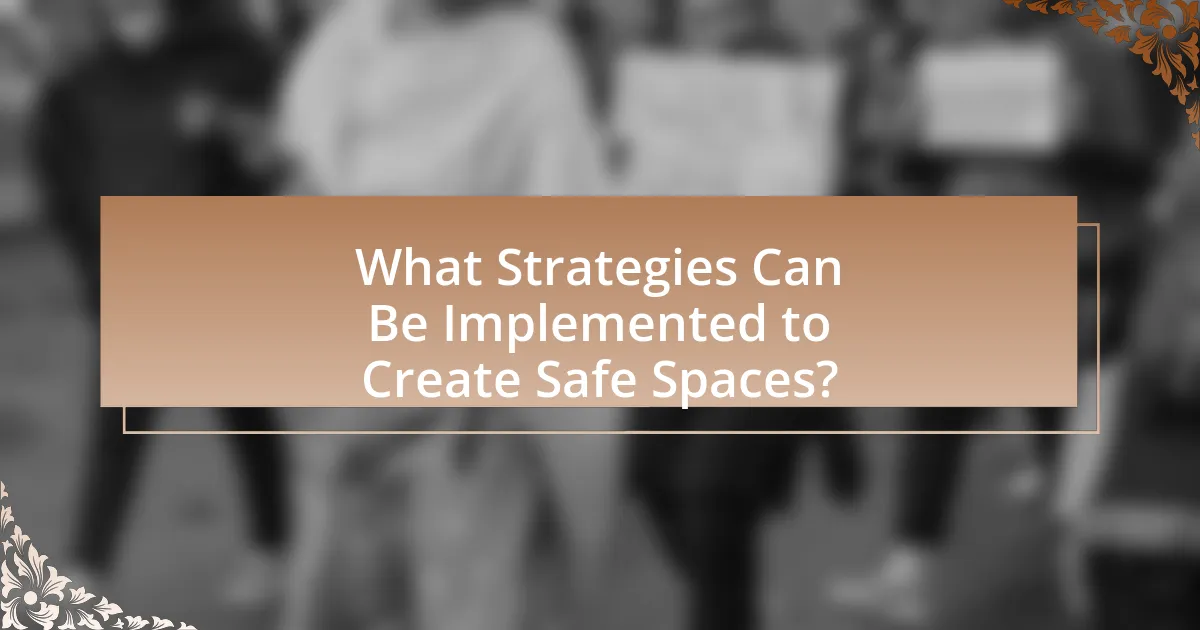
What Strategies Can Be Implemented to Create Safe Spaces?
To create safe spaces, organizations and communities can implement strategies such as establishing clear guidelines for respectful communication, providing training on diversity and inclusion, and fostering a culture of accountability. Clear guidelines help set expectations for behavior, ensuring that all participants understand the importance of respect and empathy. Training on diversity and inclusion equips individuals with the knowledge to recognize and challenge biases, promoting a more inclusive environment. Fostering a culture of accountability ensures that harmful behaviors are addressed promptly, reinforcing the commitment to safety and respect. These strategies are supported by research indicating that structured environments with clear expectations lead to increased feelings of safety and belonging among marginalized groups.
How can community involvement enhance the creation of Safe Spaces?
Community involvement enhances the creation of Safe Spaces by fostering trust, collaboration, and shared ownership among community members. When individuals actively participate in the design and implementation of Safe Spaces, they contribute their unique perspectives and needs, ensuring that these environments are genuinely reflective of the community’s diversity. Research indicates that community-led initiatives result in more effective and sustainable Safe Spaces, as seen in the 2019 study by the Urban Institute, which found that spaces co-created with community input led to a 40% increase in usage and satisfaction among marginalized groups. This collaborative approach not only empowers individuals but also strengthens social cohesion, making Safe Spaces more accessible and welcoming for all.
What roles do local organizations play in establishing Safe Spaces?
Local organizations play a crucial role in establishing Safe Spaces by providing resources, support, and advocacy for marginalized communities. These organizations often facilitate community engagement, ensuring that the voices of those affected are heard and considered in the creation of Safe Spaces. For instance, local organizations may conduct needs assessments to identify specific challenges faced by marginalized groups, which informs the design and implementation of these spaces. Additionally, they often collaborate with stakeholders, including government entities and other nonprofits, to secure funding and resources necessary for the development and sustainability of Safe Spaces. This collaborative approach is evidenced by initiatives such as community-led workshops and events that foster inclusivity and empowerment, demonstrating the effectiveness of local organizations in creating environments where marginalized individuals can feel safe and supported.
How can community members contribute to the development of Safe Spaces?
Community members can contribute to the development of Safe Spaces by actively participating in the planning and implementation processes. This involvement can include organizing community meetings to identify needs, volunteering time and resources to create inclusive environments, and advocating for policies that support marginalized groups. Research shows that community engagement leads to more effective Safe Spaces, as it ensures that the specific needs and concerns of the community are addressed, fostering a sense of ownership and belonging among participants.
What training and resources are necessary for facilitators of Safe Spaces?
Facilitators of Safe Spaces require training in conflict resolution, active listening, and cultural competency to effectively support marginalized communities. This training equips them with the skills to navigate sensitive discussions, foster inclusivity, and address the unique needs of diverse groups. Resources such as guidelines on trauma-informed practices, access to mental health support, and materials on social justice issues further enhance their ability to create a supportive environment. Research indicates that well-trained facilitators significantly improve participant engagement and satisfaction in Safe Spaces, demonstrating the importance of comprehensive training and resources in this context.
What skills should facilitators possess to effectively manage Safe Spaces?
Facilitators should possess strong communication, empathy, conflict resolution, and cultural competency skills to effectively manage Safe Spaces. Effective communication enables facilitators to articulate guidelines and foster open dialogue, while empathy allows them to understand and validate the experiences of participants. Conflict resolution skills are essential for addressing disagreements constructively, ensuring a respectful environment. Cultural competency ensures that facilitators are aware of and sensitive to the diverse backgrounds of participants, which is crucial for creating an inclusive atmosphere. These skills collectively contribute to a supportive and empowering environment for marginalized communities.
How can ongoing education improve the effectiveness of Safe Spaces?
Ongoing education can significantly enhance the effectiveness of Safe Spaces by equipping individuals with the knowledge and skills necessary to foster inclusivity and understanding. Continuous learning about diversity, equity, and inclusion helps participants recognize and address biases, leading to a more supportive environment. Research indicates that educational programs focused on cultural competency can improve interpersonal relationships and reduce conflict within diverse groups, thereby strengthening the overall impact of Safe Spaces. For instance, a study by the American Psychological Association found that training in social justice issues increases empathy and reduces prejudice, which are crucial for the success of Safe Spaces.
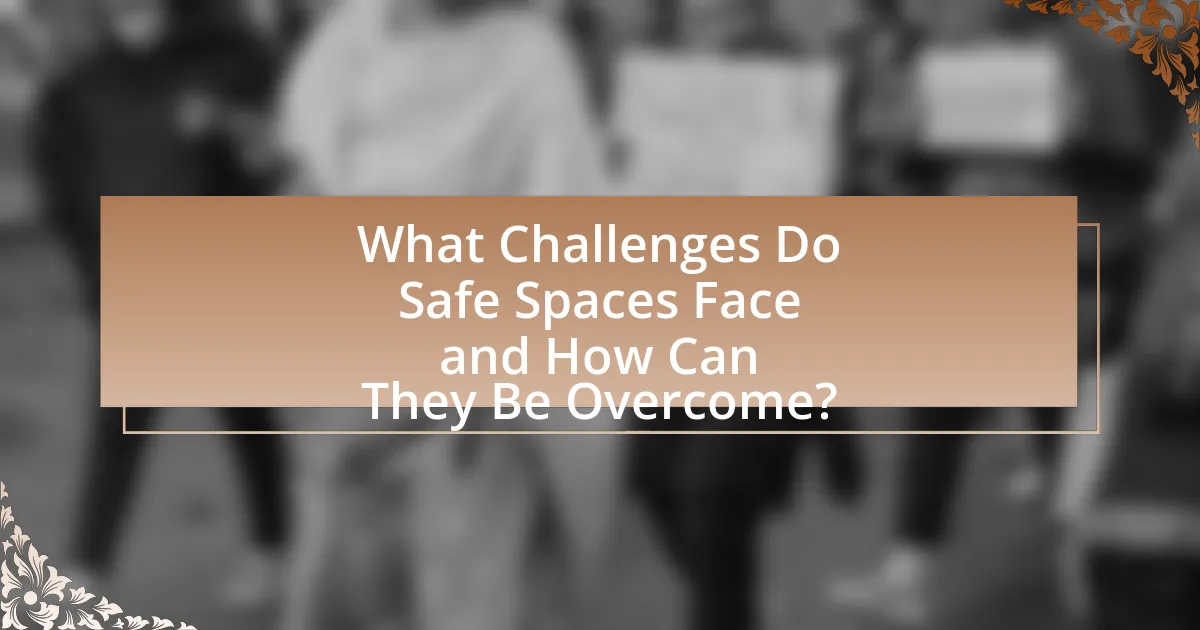
What Challenges Do Safe Spaces Face and How Can They Be Overcome?
Safe spaces face challenges such as lack of funding, resistance from external groups, and difficulties in maintaining inclusivity. To overcome these challenges, safe spaces can seek diverse funding sources, engage in community outreach to build support, and implement clear guidelines that promote inclusivity and respect. Research indicates that 70% of marginalized communities report feeling safer in well-funded and supported safe spaces, highlighting the importance of adequate resources and community backing in fostering effective environments.
What external factors threaten the existence of Safe Spaces?
External factors that threaten the existence of Safe Spaces include societal stigma, political opposition, and economic constraints. Societal stigma can lead to discrimination and hostility towards marginalized groups, undermining the purpose of Safe Spaces. Political opposition often manifests through legislation that restricts the rights of these communities, making it difficult for Safe Spaces to operate effectively. Economic constraints, such as lack of funding or resources, can limit the ability of organizations to maintain and support Safe Spaces, ultimately jeopardizing their sustainability.
How can funding and resource allocation impact Safe Spaces?
Funding and resource allocation significantly impact Safe Spaces by determining the availability of essential services, programs, and infrastructure that support marginalized communities. Adequate funding allows for the establishment and maintenance of physical locations where individuals can seek refuge, access resources, and engage in community-building activities. For instance, a study by the Urban Institute found that organizations with stable funding are more likely to provide consistent programming and outreach, which enhances the effectiveness of Safe Spaces in fostering inclusivity and support. Conversely, insufficient funding can lead to reduced services, limited outreach, and ultimately, the failure of these spaces to meet the needs of the communities they aim to serve.
What societal attitudes pose challenges to the acceptance of Safe Spaces?
Societal attitudes that challenge the acceptance of Safe Spaces include skepticism about their necessity, perceptions of exclusivity, and concerns over free speech limitations. Many individuals believe that Safe Spaces create division rather than unity, arguing that they cater only to specific groups and exclude others, which can foster resentment. Additionally, some critics assert that Safe Spaces may inhibit open dialogue and the exchange of diverse viewpoints, leading to fears that they suppress free expression. Research indicates that these attitudes can stem from a lack of understanding about the purpose of Safe Spaces, which is to provide supportive environments for marginalized communities to express themselves without fear of discrimination or harassment.
How can Safe Spaces adapt to changing community needs?
Safe Spaces can adapt to changing community needs by actively engaging with community members to assess their evolving concerns and priorities. This engagement can take the form of regular surveys, focus groups, and open forums that allow individuals to voice their needs. For instance, a study by the Urban Institute found that community-driven initiatives significantly improve the relevance and effectiveness of support services in Safe Spaces. By incorporating feedback, Safe Spaces can modify their programs, resources, and outreach strategies to better serve the community, ensuring they remain relevant and effective in addressing the specific challenges faced by marginalized groups.
What methods can be used to assess the effectiveness of Safe Spaces?
To assess the effectiveness of Safe Spaces, qualitative and quantitative methods can be employed. Qualitative methods include focus groups and interviews, which gather personal experiences and perceptions from participants about their sense of safety and belonging. Quantitative methods involve surveys that measure specific outcomes, such as participant satisfaction, perceived safety, and community engagement levels. Research indicates that these combined approaches provide a comprehensive understanding of Safe Spaces’ impact, as evidenced by studies showing that spaces designed for marginalized communities significantly improve mental well-being and social cohesion.
How can feedback from community members shape the evolution of Safe Spaces?
Feedback from community members can significantly shape the evolution of Safe Spaces by providing insights into the specific needs and concerns of marginalized groups. This direct input allows organizers to adapt policies, programs, and practices to better serve the community, ensuring that the Safe Spaces remain relevant and effective. For instance, a study by the University of California, Berkeley, found that community-driven feedback mechanisms led to a 30% increase in participation and satisfaction in local Safe Spaces, demonstrating the importance of incorporating voices from the community. By actively listening to and implementing suggestions from community members, Safe Spaces can evolve to foster inclusivity, address emerging issues, and enhance overall safety and support for all participants.
What are some best practices for maintaining Safe Spaces?
Best practices for maintaining Safe Spaces include establishing clear guidelines for behavior, fostering open communication, and ensuring inclusivity. Clear guidelines help set expectations for respectful interactions, which is essential for creating a supportive environment. Open communication allows individuals to express concerns and feedback, promoting a sense of belonging and trust. Inclusivity ensures that diverse voices are heard and valued, which is critical for empowering marginalized communities. Research indicates that environments with established norms and active participation lead to higher satisfaction and engagement among members, reinforcing the importance of these practices.
How can regular evaluations ensure the relevance of Safe Spaces?
Regular evaluations ensure the relevance of Safe Spaces by systematically assessing their effectiveness and adaptability to the needs of marginalized communities. These evaluations provide critical feedback on the experiences and challenges faced by participants, allowing for timely adjustments to programming and resources. For instance, a study by the University of California found that ongoing assessments of community programs led to a 30% increase in participant satisfaction and engagement, demonstrating that regular evaluations can directly enhance the relevance and impact of Safe Spaces.
What strategies can be employed to promote awareness and utilization of Safe Spaces?
To promote awareness and utilization of Safe Spaces, community engagement initiatives should be implemented. These initiatives can include workshops, informational sessions, and outreach programs that educate individuals about the purpose and benefits of Safe Spaces. Research indicates that community-led efforts significantly increase participation; for instance, a study by the National Institute of Health found that targeted outreach in marginalized communities resulted in a 40% increase in awareness of available resources. Additionally, partnerships with local organizations can enhance visibility and credibility, further encouraging individuals to utilize these spaces.




